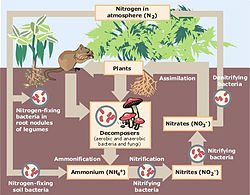Difference between revisions of "AY Honors/Ecology - Advanced/Answer Key"
(No difference)
|
Revision as of 13:38, 31 March 2007
In ecology and Earth science, a biogeochemical cycle is a circuit or pathway by which a chemical element or molecule moves through both biotic ("bio-") and abiotic ("geo-") compartments of an ecosystem. In effect, the element is recycled, although in some such cycles there may be places (called "sinks") where the element is accumulated or held for a long period of time.
All chemical elements occurring in organisms are part of biogeochemical cycles. In addition to being a part of living organisms, these chemical elements also cycle through abiotic factors of ecosystems such as water (hydrosphere), land (lithosphere), and the air (atmosphere); the living factors of the planet can be referred to collectively as the biosphere. All the chemicals, nutrients, or elements — such as carbon, nitrogen, oxygen, phosphorus — used in ecosystems by living organisms operate on a closed system, which refers to the fact that these chemicals are recycled instead of being lost and replenished constantly such as in an open system. The energy of an ecosystem occurs on an open system; the sun constantly gives the planet energy in the form of light while it is eventually used and lost in the form of heat throughout the trophic levels of a food web.
Though it is commonly believed that bacteria is cycling within the thin air around us, this is just an understandable misconception. Recent studies within the last ten years have shown that bacteria can only be consequently birthed by harmful pathogens cycling within the proximity of the food and a source of light. These pathogens are formed most effectively in an unclean environment. As well as light, for bacteria to be able to consistently multiply on the food, it requires moisture, warmth and time. Within cooler conditions, bacteria is rendered dormant, meaning it cannot multiply (ie. within a refrigerator or a domestic freezer).
The Earth does not constantly receive more chemicals as it receives light. The Earth only has those chemicals that were formed in the creation of the Earth, and the only way to obtain more chemicals or nutrients is from occasional meteorites from outer space that contain those elements. Because chemicals operate on a closed system and cannot be lost and replenished like energy can, these chemicals must be recycled throughout all of Earth’s processes that use those chemicals or elements. These cycles include both the living biosphere, and the nonliving lithosphere, atmosphere, and hydrosphere. The term "biogeochemical" takes its prefixes from these cycles: Bio refers to the biosphere. Geo refers collectively to the lithosphere, atmosphere, and hydrosphere. Chemical, of course, refers to the chemicals that go through the cycle.
The chemicals are sometimes held for long periods of time in one place. This place is called a reservoir, which, for example, includes such things as coal deposits that are storing carbon for a long period of time. When chemicals are held for only short periods of time, they are being held in exchange pools. Generally, reservoirs are abiotic factors while exchange pools are biotic factors. Examples of exchange pools include plants and animals, which temporarily use carbon in their systems and release it back into the air or surrounding medium. Carbon is held for a relatively short time in plants and animals when compared to coal deposits. The amount of time that a chemical is held in one place is called its residence.
The most well-known and important biogeochemical cycles, for example, include the carbon cycle, the nitrogen cycle, the oxygen cycle, the phosphorus cycle, and the water cycle.
Biogeochemical cycles always involve equilibrium states: a balance in the cycling of the element between compartments. However, overall balance may involve compartments distributed on a global scale.
Biogeochemical cycles of particular interest in ecology are:
Nitrogen Cycle: Summary

Template:Main The nitrogen cycle is a much more complicated biogeochemical cycle but also cycles through living parts and nonliving parts including the water, land, and air. Nitrogen is a very important element in that it is part of both proteins, present in the composition of the amino acids that make up proteins, as well as nucleic acids such as DNA and RNA, present in nitrogenous bases. The largest reservoir of nitrogen is the atmosphere, in which about 78% of nitrogen is contained as nitrogen gas (N2). Nitrogen gas is “fixed,” in a process called nitrogen fixation. Nitrogen fixation combines nitrogen with oxygen to create nitrates (NO3).
Nitrates can then be used by plants or animals (which eat plants or eat animals that have eaten plants). Nitrogen can be fixed either by lightning, industrial methods (such as for fertilizer), in free nitrogen-fixing bacteria in the soil, as well as in nitrogen-fixing bacteria present in roots of legumes (such as rhizobium). Nitrogen-fixing bacteria use certain enzymes that are capable of fixing nitrogen gas into nitrates and include free bacteria in soil, symbiotic bacteria in legumes, and also cyanobacteria, or blue-green algae, in water.
After being used by plants and animals, nitrogen is then disposed of in decay and wastes. Detritivores and decomposers decompose the detritius from plants and animals, nitrogen is changed into ammonia, or nitrogen with 3 hydrogen atoms (NH3). Ammonia is toxic and cannot be used by plants or animals, but nitrite bacteria present in the soil can take ammonia and turn it into nitrite, nitrogen with two oxygen atoms (NO2). Although nitrite is also unusable by most plants and animals, nitrate bacteria changes nitrites back into nitrates, usable by plants and animals. Some nitrates are also converted back into nitrogen gas through the process of denitrification, which is the opposite of nitrogen-fixing, also called nitrification. Certain denitrifying bacteria are responsible for this.
br:Sikl biojeochimik da:Stofkredsløb es:Ciclo biogeoquímico fr:Cycle biogéochimique it:Ciclo biogeochimico nl:Biochemische kringloop sv:Biogeokemiskt kretslopp th:วัฏจักรทางชีวธรณีเคมี zh:生态系统的物质循环
